Sinks have become an inevitable part of modern homes. In addition to being utilitarian, there has been a gross diversification in material choice and design elements over the years. Among them, fireclay and quartz are one of the most well-known options.
The main difference between fireclay and quarts sinks is their price and depth. Fireclay sinks are some of the most expensive sinks out there while quartz sinks are nominally priced. Also, fireclay sinks offer more depth compared to a standard quartz sink.
But these aren’t the only differentiating factor between the two. There are other more intricate aspects as well. Let’s have a look.
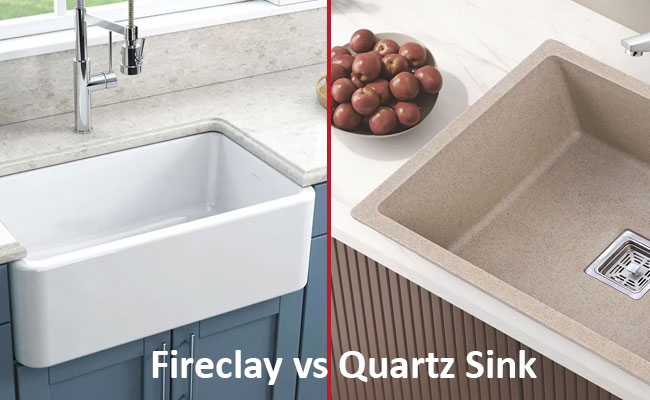
What is Fireclay Sink?
Fireclay sink is a more upscale luxury sink option made by repeatedly firing an alloy of clay and ceramic. They are heavy, well-built, and traditionally comes in either white or off-white shade. These sinks are also significantly deeper and are best suited for farm-style use.
What is Quartz Sink?
Quartz sinks are made from composite material with a mixture of acrylic and quartz. Because of its composite nature, this material is cheaper and lightweight compared to other sink options. They also replicate the look and feel of an actual stone which adds to the overall look and feel of the kitchen.
Fireclay Vs Quartz Kitchen Sink (Main Differences)
So now you know everything that is to know about fireclay and quartz sinks. But what about the real-world usage factors? There’s nothing like using something yourself to find out everything about it. But we’re here to spare you of that trouble.
Factors | Fireclay Sinks | Quartz Sinks |
Durability | Less durable compared to quartz sinks. | Quartz sinks are more durable. |
Aesthetics | Limited aesthetics with a traditional look and feel | High aesthetics as quartz sinks replicate actual stones |
Non-porous | Non-porous material | Non-porous material |
Available Types, Design, and Color | Wide range of size options but limited color and design choices | Wide range of design and color choices but limited types |
Customization | More customizable | Less customizable |
Noise proof | Doesn’t muffle sound at all | Highly noise absorbent |
Weight | Much heavier compared to quartz | Less heavy compared to quartz |
Cost | More expensive | Less expensive |
Installation type and cost | Difficult to install and accrues higher installation cost | Easy to install |
Cleaning and Maintenance | Easy to clean and maintain | Easy to clean and maintain |
Difference Between Fireclay and Quartz Sink: In Details
The differences presented in the table don’t tell the whole story. What might sound like a con might actually work in your favor depending on the setup. So, now let’s look at the differences in detail.
Durability
Winner: Quartz
Quartz takes the crown for durability even though the fireclay is an equally good contender. The composite material does an excellent job of producing a long-lasting compound that ever so slightly edges over the fireclay material.
Aesthetic
Winner: Quartz
The high aesthetic of the quartz watch with its pattern gives them an edge over the fireclay sinks. While there are several aesthetic options with the quartz material, the choice is limited on the fireclay end.
Non-porous
Winner: Both
Both the fireclay and quartz sinks are non-porous. Non-porous build helps to maintain and keep the hygiene of the sinks for a long time. So, both the sinks take the crown here.
Available Types, Design & Color
Winner: Both
This one is a difficult choice. Fireclay sinks offer different types and sizes but it misses out on the design and color. And while quartz has a range of design and color options, it certainly falls short in type diversity.
Customization
Winner: Fireclay
Fireclay sinks are mostly farmhouse-style sinks. The apron front allows for different customization regarding depth and size. While quartz is a bit more flexible material-wise compared to fireclay, it doesn’t offer an equivalent level of customization as the fireclay does.
Noise proof
Winner: Quartz
Quartz uses 20-part acrylic in its composition which makes it a great sound absorbent. No matter what you drop in the sink, all you’ll hear is a blunt thud instead of a full-on bang.
Weight
Winner: Quartz
The composite build of the quartz allows for a very lightweight design that is easy to carry. However, it doesn’t compromise durability. Compared to that, fireclay sinks are much heavier.
Cost
Winner: Quartz
Quartz easily wins over Fireclay here as they cost significantly less compared to the Fireclay counterpart. Part of the reason is the intricate process of making a fireclay sink and the cost of material involved.
Installation Type and Cost
Winner: Quartz
Fireclay sinks can only be mounted using an under mount because they are very heavy. On the other hand, quartz sinks can be mounted in different ways thanks to the lightweight build.
Cleaning & Maintenance
Winner: Both
Both quartz and fireclay sinks are easy to maintain and clean. However, fireclay sinks are known to chip at times and quartz can pick up scratches that especially look bad on a white finish. So, we suggest you be careful while using and maintaining appropriately.
Pros and Cons of Fireclay Sinks
Fireclay sinks aren’t that common. It’s mostly seen in high-end homes with farmhouse sinks as the customization options are limited. However, they are still in vogue and offer value relative to the price. Let’s look at the pros and cons.
Pros
- Easy to maintain
- Resistant to wear and tear over time
- Requires less space to set up
- Comes with substantial depth
- High resistance to elements
Cons
- Can be loud while using
Pros and Cons of Quartz Sinks
While in all aspects, quartz sinks might look like the obvious choice. It looks modern, is cheap, and comes in a natural look. But there are other aspects to take hold of as well.
Pros
- Long-lasting
- Sound muffler
- Can withstand high heat
- Looks like a natural stone composite
- Lightweight design
Cons
- Limited customization options
- Prone to scratches and dents over time
Fireclay Vs Quartz Sink: Which One Should I Choose
Two things should be considered to answer this question – budget and preference. Quartz brings high fashion to the kitchen with its aesthetic finishes and lightweight material. It looks good and durable and costs much less compared to the fireclay sinks.
However, if high aesthetics aren’t your thing, luxury might be. Fireclay sinks offer the traditional suave of royalty with their hefty build and shiny finish. If you have the cash to spare, we see no reason why you shouldn’t opt for a fireclay sink.
FAQs
Beyond the pros and cons and differences, there are other common queries regarding fireclay and quartz sinks. Let’s look at them now.
- Do fireclay sinks scratch easily?
No fireclay sinks do not scratch easily. You need to make a heavy impact to scratch or dent the surface. However, it can break with a hard enough impact.
- Will a quartz sink scratch?
Not easily, no. Just like fireclay, the impact needs to be strong and sharp for any kind of dent or scratches. You’re good enough for a long time as long as you’re careful with the dishes.
- Why is my black quartz sink turning white?
The soap and the mineral from the water tend to build up a white scale on a black or dark-colored quartz sink. This scale cannot be removed with ordinary cleaning material. You will need specific scale cleaners like baking soda and white vinegar for this purpose.
- Can you use a garbage disposal with a quartz sink?
Yes, it is possible to use a garbage disposal with a quartz sink. But be sure to use a quartz flange with the disposal for ease of use.
- What stains are easier quartz or granite?
Granite tends to stain easily compared to quartz. This is because quartz has a layer of resin on them which makes them immune to easy staining.
To sum-up
To wrap up here, both quartz and fireclay are excellent choices for kitchen sinks. They both offer their unique proposition which makes them perfect for their target demographic.
In our review, we found that both quartz and fireclay sinks are incredibly durable and long-lasting, which is often the main criteria when choosing a kitchen sink. So regardless of whichever one you choose, it will surely be worth the money.
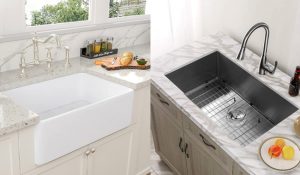
Porcelain Vs. Stainless Steel Kitchen Sink – Detailed Comparison
A well-structured and installed kitchen sink has the power to enhance the look of a kitchen. The materials used to make a sink play a
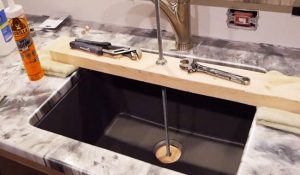
How to Install an Undermount Sink to a Granite Countertop
Plumbers are becoming expensive to hire for installing an undermount sink and it becomes costly for us. How it feels if you install it on your
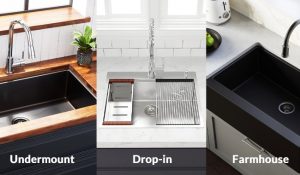
Undermount vs. Drop-in vs. Farmhouse Kitchen Sink
It is tough to imagine a house without a kitchen, right? Imagine you are planning to make a special meal and you have no sink
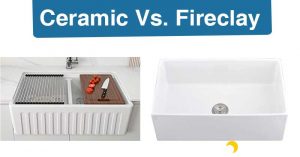
Ceramic Vs. Fireclay Sink | Which One Should You Choose?
Kitchen sinks are no longer simple and boring. Nowadays, there are several designs and materials to choose from when choosing a sink. Among these materials,
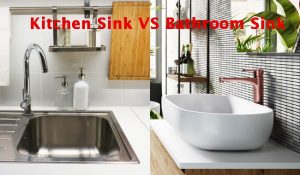
Differences Between Kitchen Sink and Bathroom Sink
The kitchen sink and the bathroom sink both serve as an important part of our daily routines. They are both needed for normal day-to-day activities.
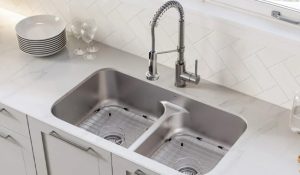
Things You Need to Know About Brand Kraus (as Sink and Faucet)
Sinks and faucets are one of the most important parts of a conventional home or work-loaded office nowadays. Perhaps, you cannot think about a kitchen




